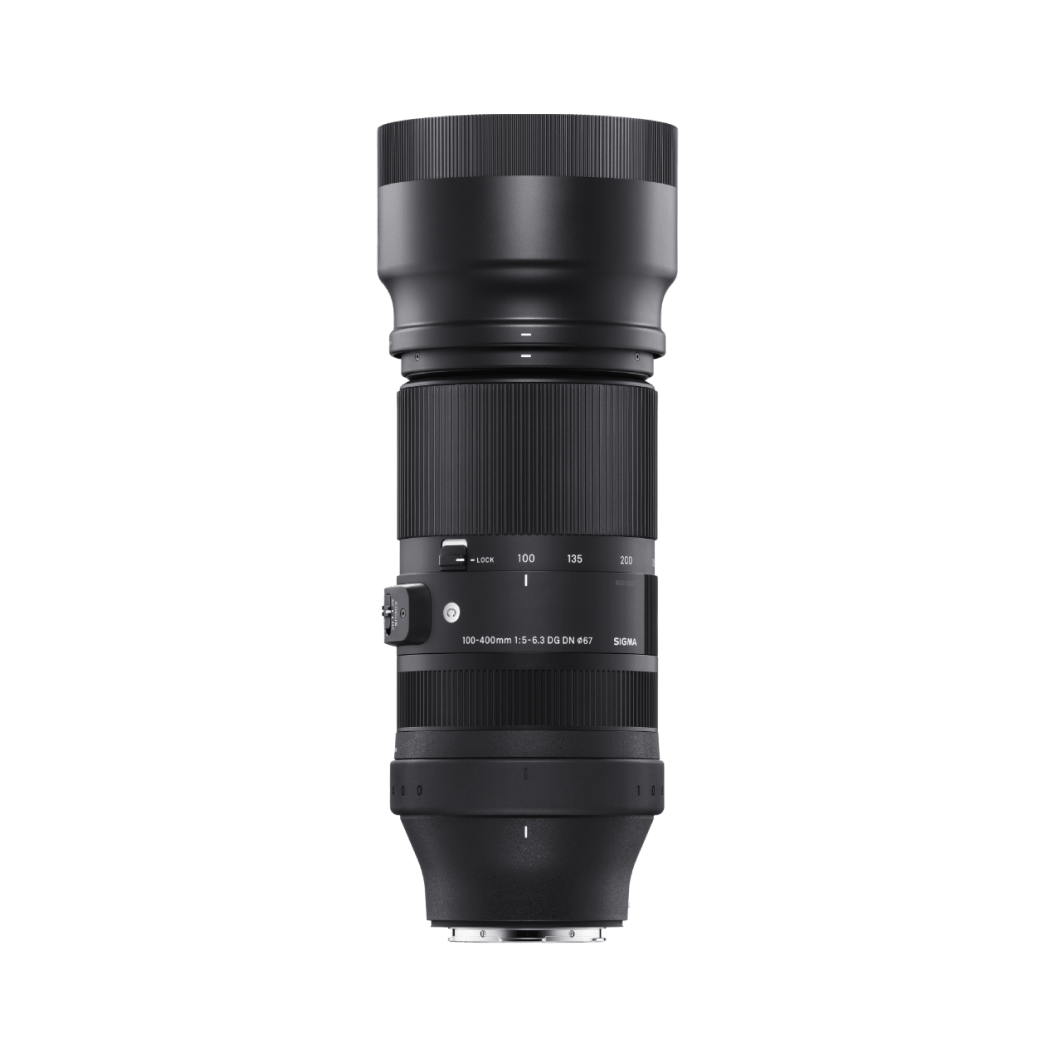

Contemporary
100-400mm F5-6.3 DG OS HSM
Available mounts
- SIGMA SA-mount
- Canon EF mount
- Nikon F mount
-
Camera Type
DSLR
-
Corresponding Mount
SIGMA SA-mount, Canon EF mount, Nikon F mount
-
Sensor Format
Full-frame [DG]
-
Lens Construction
21 elements in 15 groups
-
Angle of View
24.4° - 6.2°
-
Number of Diaphragm Blades
9 (Rounded diaphragm)
-
Minimum Aperture
F22
-
Minimum Focusing Distance
160cm / 63in.
-
Maximum Magnification Ratio
1:3.8
-
Filter Size
φ67mm
-
Dimensions (Diameter × Length)
φ86.4mm × 182.3mm / φ3.4in. × 7.2in.
*The length of a lens is measured from the filter surface to its mount.
-
Weight
1,160g
-
Edition Number
C017
The three-digit code on the surface of the lens is to indicate the year the lens was first released.
(Since it is different from the year of manufacture, the release year and edition number may not match depending on the mount.) -
Supplied Accessories
・LENS HOOD LH770-04
・FRONT CAP LCF-67mm III
・REAR CAP LCR II -
Mount / Product Barcode
SIGMA SA-mount:00-85126-72956-1 (discontinued)
Nikon F mount:00-85126-72955-4 (discontinued)
Canon EF mount:00-85126-72954-7 (discontinued)
-
Camera Compatibility
LINK
-
*Values are for Sigma SA-mount
*The Nikon mount version of this lens includes an electromagnetic diaphragm mechanism. Functionality may be limited on some camera bodies.
*For Nikon F mount cameras, please see (*)Nikon camera compatibility(*)Nikon F mount camera compatibility
Lenses for Nikon F mount with an electromagnetic diaphragm mechanism can be used with the following cameras.
Z7Ⅱ※,Z7※,Z6Ⅱ※,Z6※,Z5※,Z50※,D6, D5, D4S, Df, D850, D810, D810A, D780, D750, D610, D500, D7500, D7200, D7100, D5600, D5500, D5300, D5200, D5100, D5000, D3500, D3400, D3300, D3200, D3100
※Can be used with the Nikon "Mount Adapter FTZ" attachedBefore using with one of the cameras listed below, please update the lens to the latest firmware version.
D4, D3X, D3S, D3, D800, D800E, D700, D600, D300S, D300, D7000
* The lens cannot be used with the cameras not listed above (including film single‐lens reflex cameras).
Lens construction

SLD glass
MTF Chart
The MTF (Modulation Transfer Function) is one of the measurements for evaluating a lens’ performance, and it shows how faithfully the contrast of the subject can be reproduced on the image plane. The horizontal axis shows the image height (distance from the center of the image in mm) and the vertical axis shows the contrast value (maximum value is 1).
The closer the 10 line pairs/mm curve is to 1, the higher the contrast and clarity of the lens is, and similarly, the closer the 30 line pairs/mm curve is to 1, the better the resolution and sharpness of the lens is.
*The MTF chart depicts the result at the wide-open aperture.
*For mirrorless lenses that support distortion correction, the horizontal axis shows the image height equivalent to when an L-Mount lens is attached to a Sigma L-Mount camera with distortion correction applied. (The effect of distortion correction may differ depending on the mount and camera used.)
*The spatial frequency indicates the variation on the image plane before distortion correction is performed.
-
Spatial frequency
S:Sagittal Line
M:Meridional Line
-
10lp/mm
-
30lp/mm
Diffraction MTF

Diffraction MTF

Geometrical MTF

Geometrical MTF

Distortion
effective distortion
When you take a picture of a lattice pattern, it will appear as the blue dotted line shows. The red line illustrates how the lattice pattern will appear in the actual picture when any lens distortion is taken into account.
relative distortion
In this chart, the horizontal axis shows the ideal image height (the distance from the center to the edge of the image [mm]). The vertical axis shows the extent of distortion. The extent of distortion is represented by how much Y, which is the actual image height, grows (or shrinks) against Y0 which is the ideal image height.
When you take the picture of a square object, if the distortion amount shows a minus value, the image will be seen as expanded (Barrel distortion). If the distortion amount is a plus value, it will be seen as a recessed (Pincushion distortion). When the distortion value is close to 0, the appearance of distortion is very minimal.




Vignetting
The horizontal axis shows the image height (the distance from the center to the edge of the image [mm]).The vertical axis shows the amount of light in the image (based on the amount of light in the image center being 100%). If the peripheral amount of light is lower than the center, the four corners of image will be darker (vignetting).
-
F5(100mm) - F6.3(400mm)
-
F11(100mm) - F11(400mm)
-
F22(100mm) - F22(400mm)

